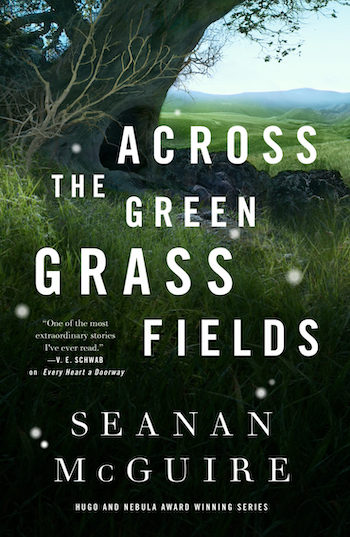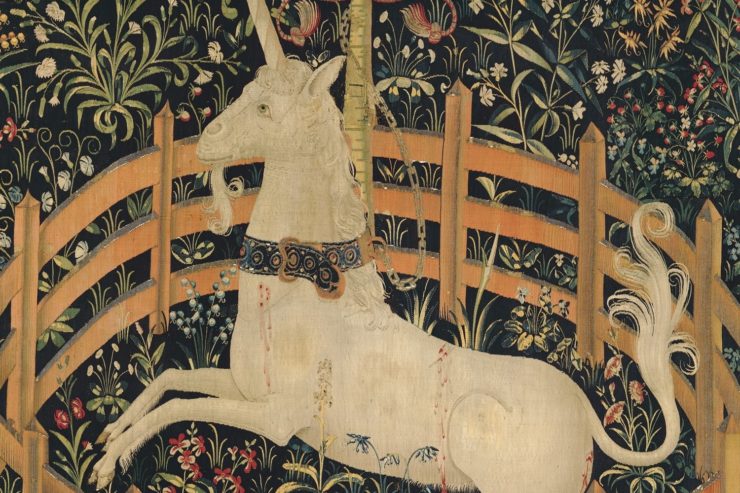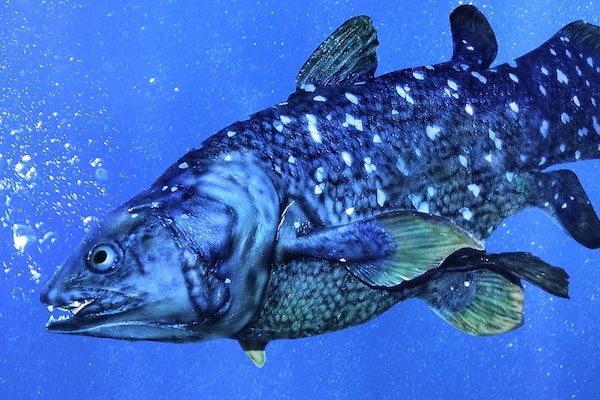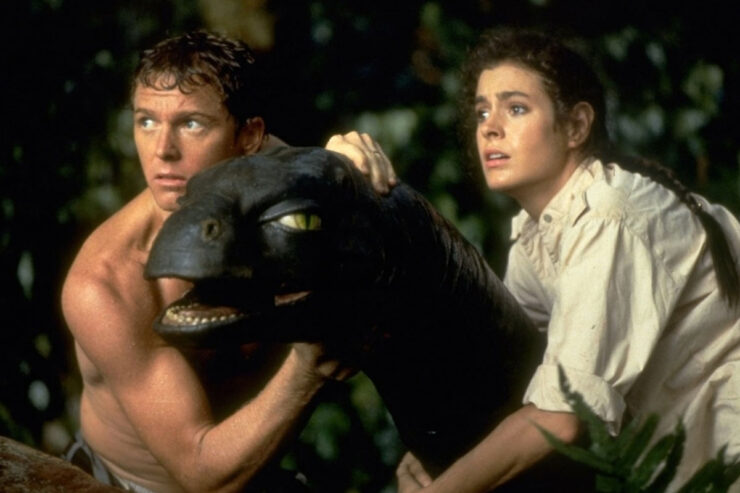The unicorn is one of the most iconic of all the mythical creatures our culture knows. It’s a myth and a legend. It’s a metaphor and allegory. It’s an entire marketing category aimed predominantly at preteen girls.
It’s ancient. It’s not just a Western phenomenon: the first we know of seems to have appeared in Mesopotamia. It’s been seen in India and China. The beast with the single horn may be an accident of perspective—a profile of an ox—or a fluke of perception, a rhinoceros as seen by an observer from a far country. It may even be a mistranslation of an original text, so that the Hebrew aurochs becomes the Greek monoceros and the Latin unicorn.
As the late Western Middle Ages shaded toward its Renaissance, the unicorn as we now know it came close to its final form. White, for purity. Armed with a long, straight, spiral horn, just like a narwhal’s horn. Cloven-hooved and tassel-tailed, more like a goat with a single horn than a horned horse. The horse came somewhat later, probably because it was perceived as nobler (and larger).
The unicorn that farts rainbows and courts little girls is the descendant of the wild creature who could only be tamed by a virgin. She would stand in its path and it would stop and lay its head in her lap. Then the (male) hunters could catch and kill it.
This is all very allegorical and religious and not incidentally sexual. Maiden tames the savage beast. Savage beast falls prey to her violent friends and relatives.
When the magical narwhal-horned goat-creature became the fantastical horned horse, it lost most of its allegorical gloss and became a more or less straightforward mythical beast. The sweet rainbow manifestation took over the toy and home-furnishings industry. But it wasn’t all sweetness and multicolored light. The dark side got to play, too. Vicious killer attack unicorns served as an antidote to the achingly sweet mainstream version.
After all, this is an animal with four sledgehammer hooves and a deadly weapon on its forehead. The horn isn’t just a hanger for flower garlands. It’s a meter-long, sharpened spear.
On the literary side of things, unicorns haven’t gained the traction that dragons have. Between Smaug and the dragons of Pern, the bestseller lists have been dominated for decades by the big flaming worms. The only comparable unicorn novel is the beloved classic by Peter S. Beagle, which I will be talking about next week.
Unicorns for the most part have played supporting roles in fantasy and the very occasional science fiction works. There’s Madeleine L’Engle’s Gaudior, who is a close relative of the medieval allegory of the pure wise creature with the shining horn. Meredith Ann Pierce’s Firebringer novels give us a unicorn protagonist who is also a quite believable relative of the horse. More recently, Diana Peterfreund has given us outright killer unicorns—and, as I ponder this, I realize I must read these, too. Nor let us ever forget Charles Stross’ utterly horrible and gleefully evil Equioids, who are everything the rainbow subspecies is emphatically not.
Buy the Book


Across the Green Grass Fields
And yet, even while the modern mainstream unicorn has been coated in rainbow sugar, the bloodthirsty antidote harks straight back to the original beast. If the traveler’s tale that spawned some of the ancient versions is in fact based on the rhinoceros, the idea of a dangerous animal that has to be hunted in self-defense has a certain persuasive logic. Rhinos are big, powerful, and have terrible vision. They charge first, ask questions later.
And yet the real rhinoceros is not nearly so evil or violent as legend makes it. Baby rhinos are frankly adorable, bouncy and playful and utterly charming. They grow into armored tanks, but they aren’t randomly violent and they can be amazingly gentle when they don’t feel threatened.
There’s a lesson there for us humans. The image of the unicorn tamed by the gentle (and treacherous) virgin has a lot to do with Western medieval attitudes toward sex, violence, and the natural world. But it also says something about the power of gentleness and understanding—something that animal trainers have been emphasizing more and more over the years.
If you attack an animal, it will naturally fight back. If you approach it softly, without aggression, and paying attention to what it’s telling you, it may lay its head in your lap. Or at least, if it warns you not to even think about it, you’ll get away safely while it goes on about its business.
Judith Tarr is a lifelong horse person. She supports her habit by writing works of fantasy and science fiction as well as historical novels, many of which have been published as ebooks. She’s written a primer for writers who want to write about horses: Writing Horses: The Fine Art of Getting It Right. She lives near Tucson, Arizona with a herd of Lipizzans, a clowder of cats, and a blue-eyed dog.















I’d never made the connection that the step after virgin lap is unicorn murder. In the stories I’ve read, the point of baiting a unicorn is to get a high quality mount. Which probably also has sexual connotations.
Charlie Stross’s “ Equoid “ is available free right on this website!
https://www.tor.com/2013/09/24/equoid/
Also, the Horrible Truth about unicorn horns:
https://mobile.twitter.com/cstross/status/984853799104806912
The unicorns introduced in the Rivers of London series book 5—titled Foxglove Summer—are vicious carnivores of fairyland.
Okay, this is incredibly tangential, but I always like to bring up the story collection by Anne McCaffrey, which was supposed to be titled “Get of the Unicorn,” but after some typographical problems ended up being “Get Off the Unicorn,” which has rather different implications.
@3 – I just read that book and was hoping to see it mentioned in the post. Nice!
Of course, there is also the unicorn that plays a big role in the final book in the original wrap up to Zelazny’s Amber chronicles – picking the next ruler of Amber.
And speaking of Zelazny, there’s also Tlingel the chess-playing unicorn from “The Unicorn Variation.”
Guy Kay’s Fionavar Tapestry featured a very dangerous variety of unicorn, iirc.
@1 The medieval unicorn was not a riding animal. Too small–it was the size of a deer–and the point of it was to trap and kill it and steal its magical healing horn. Unicorn as riding animal is a modern variation.
@2 I can’t decide if I love Charlie or hate him for this.
Excellent additional references, thanks all!
@8 I seem to recall a certain article about Centaurs…
My own favorite unicorns are the enigmatic beasts of Pamela Dean’s “Secret Country” books. Not quite as whimsical as the dragons, perhaps, but very much have their own agenda.
The unicorn in Terry Pratchett’s Lords and Ladies is also a killer.
In the early 19th century, there were rumors of unicorns in the southern part of the newly acquired Louisiana Territory–in the Red River country, if I recall correctly. This was shortly after Jefferson asked Lewis and Clark to keep an eye out for mastodons and giant sloths, on the grounds that anything could be out there.
Or there’s always Avram Davidson’s Adventures in Unhistory, specifically “The Spoor of the Unicorn.” (I highly recommend that one, tracing unicorns through mythological history.)
Kudos for this article:)

There’s also the unicorn Breeze in Blue Moon Rising and the sequels by Simon Green. Also has a wonderful take on dragons and in fact, skewers just about every fantasy trope.
The story “The Silken-Swift” in the collection E Pluribus Unicorn by Theodore Sturgeon explores the traditional “virgin tames unicorn” theme in a somewhat unexpected way. It’s been quite a few years since I’ve read it.
Link to “The Silken-Swift” by Theodore Sturgeon: https://www.baen.com/Chapters/9781625791177/9781625791177___2.htm.
I’m sorry, but unicorn marketing is first and foremost geared towards us queers!


There was an attempt around 30 years or so ago to create a “real” unicorn. Tim Zell (Church of All Worlds) had the horn buds of young goats surgically moved to the center of the forehead so they fused into a single horn. His contention was this was done in ancient times to make an aggressive animal with a single horn as a guard for the flock. I saw one of them when they were attractions at the Texas Renaissance Festival one year, and I heard later they toured with Ringling Brothers.
@19 This was first done surgically on a cow back in the 1940s, I believe. The animal turned out to be very gentle and would use her horn for simple tasks like lifting latches on gates.
It’s been argued that true unicorns are impossible – a single medial frontal horn in a cloven-hooved animal wouldn’t occur in nature, as the frontal bone is actually paired and the structures it bears will be as well. This surgery was performed to show that there’s a way around this constraint.
I first hit a 404 on the link in #17. Deleting the underscore and everything after worked to reach Unicorns by Gardner Dozois and Jack Dann.
Most anybody who ever read the story will remember it
The unicorns of my childhood reading in fantasy: Jewel in C. S. Lewis’s The Last Battle, a regular “talking animal” Narnian, though a noble one who is never fooled by the fake Aslan; Findhorn in Alan Garner’s Elidor, who saves the desolate land of Elidor with his song at his redemptive death; and in Lynette Muir’s The Unicorn Window, the real unicorn in the shield-shaped land of Armourie who represents/enables the unicorn device used in heraldry. When the twins break the stained glass window in our world showing the unicorn crest, the unicorn in Armourie escapes from its field; the girl of the twins must be the one to capture it–but in this case, not so as to enable hunters to kill it, but only to enable them to get it back in its field.
I recall a friend’s mother having the Unicorns! anthology. That simple, distinct cover is etched into my brain from childhood. Looking at the contents online, I’d like to read it now.
No one has yet mentioned the movie Legend, with Tim Cruise, Mia Sara & Tim Curry. One of my favorite movies, along with Ladyhawke.
The old Microdeal computer game Time Bandit, which I used to play on my Commodore Amiga, had a unicorn called Kelvashan that appeared when you completed all 16 levels of one of the worlds. You had a choice of how to respond. Refusing to enslave Kelvashan was the best option, as they then granted you a boon that proved useful in other worlds.
@24 Ah yes, Tim Cruise, star of stage and screen! Never made it as far as his brother, but damned if he didn’t look good in a scaled shirt and a loin cloth. (Just teasing, I love Legend, one of my all time faves.)
The Witcher series features some interesting Unicorns, beautiful but much more cerebral and cold than they are usually depicted. Elves hate them, and the feeling is mutual.
Guy Gavriel Kay makes his a beautiful weapon of war, and Cathrynne M Valente made hers quite beastly, but powerful. A creature of vicious temper and innate violence as I recall, that could only find peace when an innocent was nearby.
I think I remember reading a Mercedes Lacky book featuring a boy riding a uinicorn to war, a notable plot point was the boy maintaining his virginity so as not to lose his powerful ally and friend (which ends up being a bit harder than it sounds!).
I’ve always liked the marrying of the concepts. A creature of purity and love, that is also very very dangerous. It will love you even as it pierces your heart with its horn, because it must, because there’s something dark hiding in you, and it was made to shine a light in dark places.
Anne McCaffrey was brought up twice but no one mentioned her unicorn series! One of her later series was the “Acorna” series, where a trio of asteroid miners in deep space find an emergency pod with a baby girl in it – one who has a horn growing out of her forehead, which she later is able to use to heal, and purify air and water… In later books they track down her home planet and learn that they are actually descended from the ki-lin, unicorns rescued from Earth eons ago by another mysterious species that engineered them into bipeds. I can’t think of any other examples of “Unicorns in Space!!!” but this certainly is one! Different books in the series were written with various coauthors.
I also have to mention Bruce Coville’s wonderful YA quartet “The Unicorn Chronicles”, which start with a young girl getting pulled into Luster, a parallel world where unicorns long ago took refuge from the Hunters here on Earth – but the Hunters are still trying to find them. (I just went to check titles on Wikipedia and saw that the books are being republished as a seven book series – splitting a couple of the longer ones and also adding some new chapters!!! This is exciting!)
There is also a callback to his incredible book “Jeremy Thatcher, Dragon Hatcher” in which dragons also went to a new world – but there were a few who chose not to go, and when they changed their minds, they could no longer reach the same world the others went to. The last seven went to Luster.
Joy Chant’s Red Moon and Black Mountain has unicorn-riding nomads if I recall correctly (it ha been a very long time since I read the book).
Since no one else has yet mentioned it, I’ll bring up Tanith Lee’s YA classic, The Black Unicorn. Though I haven’t read it in years, the idea of the unicorn bones discovered in the desert, reassembled by Tanaquil, and suddenly come to life is an image that has really stayed with me over the years… as has the scene when Tanaquil goes through a gate into the world where the unicorn comes from. The fact that Lee let her protagonist just be angry when she discovers that her mere presence is corrupting the perfection of the Unicorn’s world instead of having her just be humbly grateful to have experienced it or something seemed more powerful- as well as more realistic- to teenaged me.
If we’re talking unicorns, I’ve got to mention The Dragon and the Unicorn by A.A. Attanasio, and the accompanying series, especially given the comment about dragons versus unicorns in terms of popularity (granted the “Dragon” in this book not what most would consider a dragon, and the unicorn is a magical space unicorn).
wow, nobody here read th strips?
Phoebe and her unicorn (formerly as Marigold Heavenly Nostrils)
is a great daily strip drawn by Dana Simpson.
https://www.gocomics.com/phoebe-and-her-unicorn
At least some of the medieval bestiaries depicted unicorns as very badass beasts, large, violent, with a typical medieval clashing-colours palette (can’t remember if the tongue was bright red or vibrant blue), the kind of critter that would gore a lion through and through without thinking twice. In this version, that’s the point of the virgin–the unicorn was just too tough to hunt normally, the only way your hunting party wouldn’t just get slaughtered was to use that virgin to get it to calm down and go to sleep, so you could murder it.
I’m surprised that the author did not mention that the unicorn is the national animal of Sotland!
My Apocalypse book club read Ariel by Steven R. Boyett features the classic unicorn who attaches itself to a virgin, but in this case it’s Peter, a young guy caught in a strange apocalypse where technology no longer works and fantastical creatures and magic suddenly exist.
One of the most beautiful, and terrible, unicorn scenes is in T H White’s The Witch in the Wood, later rewritten as The Queen of Air and Darkness to become part of the quartet The Once and Future King. It’s the reason I’ve been collecting unicorns for more than 40 years, long before they became prettified for small girls. Real unicorns are fierce, uncompromising creatures who are not to be tamed. Good mention for Elidor, and Joy Chant’s magical series, of which The Grey Mane of Morning is the best. Looking forward to the discussion on The Last Unicorn, another favourite book.
Piers Anthony has a very quirky take on unicorns in his Apprentice Adept series. In the overlapped worlds of Photon (science fiction) and Phaze (fantasy), one man, Stile, must master and unite both worlds. In Phaze, unicorns are limited shapeshifters, with usually three or occasionally four shapes: their natural unicorn shapes, usually a human form, plus another animal form of something useful or interesting that can vary widely, from birds, cats, or even insects. Not only that, but their unicorn horns are hollow and magically sound like a particular instrument that varies between individuals, so together a herd plays like an orchestra. In addition (!), almost all of them are wildly colorful, not pure white. In fact, one of the main characters is a small unicorn girl who is looked down on by her herd for being monochrome (mostly black) rather than colorful. In a neat inversion of the usual unicorn myth, Stile has to ride and tame her.
Two other very different (from each other, not from other takes on unicorns) examples would be the gay unicorn Drom from Alan Dean Foster’s Spellsinger series and the imprisoned unicorns of Terry Brooks’ The Black Unicorn, the second volume of his Magic Kingdom series. First one always makes me laugh (particularly the scene when the obligatory virgin girl being forced to try and lure him in naturally fails–but he’s so kind to her regardless!). Second one always makes me cry.
@telyni: Yes!!! Another long-time favorite of mine.
@26, the Mercedes Lackey thing you’re thinking of is the Obsidian trilogy she wrote with James Mallory, starting with The Outstretched Shadow. I immediately thought of that one too, it was a good series and I don’t see a lot of discussion of it.
As @11 mentions, Pratchett ‘s Lords and Ladies was my first experience with a more traditional depiction of the Fair Folk, although his unicorn, mountable and wrathful, may not be as representative of early presentations.
(Were unicorns historically depicted as dangerous, or just mysterious and unobtainable?)
The Dresden Files similarly depict the Fae and their Unicorns as powerful, haughty, and often malevolent (or rather, semi-sapient beings unable to act outside of their foretold roles).
Just to note that I am loving all the recommendations and additions. That’s prime commentary, that is. Thank you all.
Now that I come to think of it, Madeleine L’Engle had unicorns in Many Waters as well, though they played a much smaller role than in A Swiftly Tilting Planet.
Marco Polo reported unicorns in East Asia that were terrifying and aggressive, attacking and killing elephants. His tales were based upon the Indian rhinoceros, if his description (stripped of much dubious detail) is to be believed.
Two items to add to this conversation.
First is a “real world” mythology detail: unicorn bones are the colour of cinnabar (an ore of mercury and a sort of rusty red). I think they’re unique in that way; I don’t recall any vertebrate creature real or mythological, having bones that aren’t off-white “naturally”.
Second is fictional, a throwaway line in one of Seanan McGuires books about the Law of Unintended Consequences. Humanity made unicorns extinct because they were grumpy and likely to kill you as soon as lay eyes on you, and they’d kill a handful of people a year, yet as soon as they’d been eradicated from an area, deaths from dysentery and other water-born diseases would increase by far more because the unicorns presence in the ecosystem purified the local water, making it safer to drink… I thought that was a nice detail.
I also liked how Pratchett’s unicorn got shoed in silver to free it from the fairy Queen’s control, as being shoed in iron, being a fey creature, would kill it. Suggests it had a horse-like hoof (although Jason Ogg had the mystical ability to shoe anything brought to him, due to being the farrier for Death, as long as he shoed it, including an ant).
_The care and feeding of your baby killer unicorn_ by Diana Peterfreund appears in the excellent anthology Zombies Vs Unicorns edited by Holly Black and Justine Larbalestier, also including stories by Garth Nix, Naomi Novik, and Margo Lanagan.
Mercedes Lackey’s virgin-obsessed unicorns get cameos in her 500 Kingdoms books. These stories are fairytale inspired, lighthearted with large helpings of romance and humor.
Hooves of Death webcomic on Webtoon looks promising though the art style may not be everyone’s cup of tea.
Shout out to My Little Pony: Friendship is Magic for the lore and villains. Zoe Saldana voiced a memorable broken-horned unicorn warrior in the 2017 movie. The MLP comic books are top notch as well.
@43 – there’s a breed of domestic chicken, the Ayam Cemani, which is so heavily pigmented that it’s bones are black.
And there are some species of lizard that have green bones. They retain toxically-high levels of biliverdin in their tissues. Biliverdin is the compound that makes bile green. Tastes terrible.
One of China’s Treasure Fleets went as far as East Africa. They brought a giraffe home and explained that it was a unicorn. I’m not sure what the Chinese unicorn looked like. But the giraffe is one of those “There ain’t no such critter!” sort of critter. You could call it anything.
@@@@@ 33, ScottyDog:
I’m surprised that the author did not mention that the unicorn is the national animal of Scotland!
This ditty is supposed to date back to 1693, when James VI of Scotland became James I of England. Scotland had unicorns, England had lions.
The lion and the unicorn/Were fighting for the crown/The lion beat the unicorn/All around the town.
Some gave them white bread,/And some gave them brown;/Some gave them plum cake/and drummed them out of town.
And when he had beat him out,/He beat him in again;/He beat him three times over,/His power to maintain.
My first experience with unicorns was the cover of _A Spell Is Cast_ by Eleanor Cameron, which features a girl holding a unicorn chess piece [that’s even in the book!].